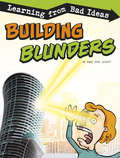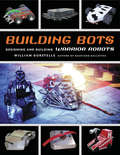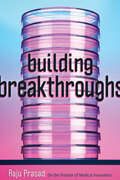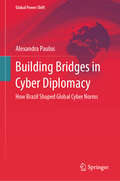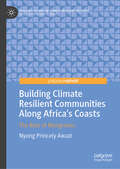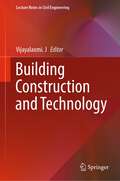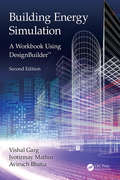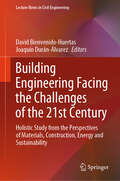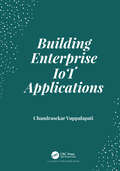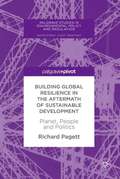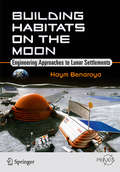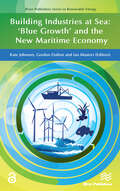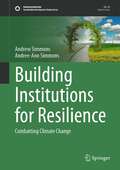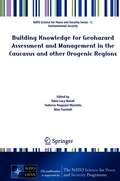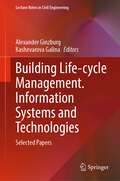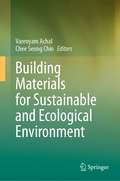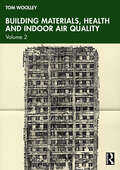- Table View
- List View
Building Blunders: Learning from Bad Ideas (Fantastic Fails)
by Amie Jane LeavittSee some of the world's biggest building blunders up close and personal. Find out how each structure failed, the basic building block that was missed during construction, and what engineers learned from their mistakes.
Building Boats that Float (Fun STEM Challenges)
by Marne VenturaWhat does it take to make a boat float? Gather some supplies and try it out for yourself! Discover tips and ideas on how to build the best boat around!
Building Bots: Designing and Building Warrior Robots
by William GurstelleThis is the definitive guide to designing and building warrior robots like those seen on BattleBots, Robotica, and Robot Wars. It walks robot enthusiasts of all ages step-by-step through the design and building process, enabling them to create any number of customized warrior robots. With a strong emphasis on safety, chapters include designing a robot, choosing materials, radio control systems, electric motors, robot batteries, motor speed controllers, gasoline engines, and drive trains. Clear instructions are accompanied by photos, line drawings, and detailed diagrams throughout. A color section showcases a variety of glorious fighting machines. For beginners, there is machine shop 101 and robot physics, and, of course, chapters on weaponry that include spinner robots, thwackbots, cutting blade robots, lifters, and chameleon robots. When the bot of their dreams is built, suggestions on where to compete and game-day strategies and tactics help readers take the next step. An extensive resource section lists parts suppliers, pertinent Web sites, a radio frequency chart, and a glossary.
Building Breakthroughs: On the Frontier of Medical Innovation
by Raju PrasadFrom mRNA vaccines to gene therapies, the next frontier of medical innovation is here.In Building Breakthroughs, Raju Prasad tells the story of important advancements in biotechnology and medical innovation from gene therapies to mRNA vaccines, providing historical context and examining cutting-edge research. Based on in-depth interviews with both the scientists who developed these discoveries and the patients who have benefited from them, Building Breakthroughs reveals the key players behind drug development and the inner workings of this essential business. Through stories of patients and their families, and of the researchers creating new treatments, Prasad reveals how cell therapies are advancing to treat childhood leukemia and a form of lymphoma, how a gene therapy was established to treat the rare disease spinal muscular atrophy type I, and potentially curative therapies that are being developed for sickle cell disease. By examining the clinical trial and regulatory paths each therapy took to reach approval, Prasad uncovers the building blocks of biotechnology innovation and the investments that must be made to catalyze the development of future breakthroughs. He also explores issues of scientific communication and misinformation, providing recommendations for improvements in the future.For those seeking to understand the vitally important processes that lead to new medicines and the surrounding ecosystem that is enabling the next generation of innovative medicines with the potential to transform patient outcomes, Building Breakthroughs is essential reading.
Building Bridges at the Science-Stakeholder Interface: Towards Knowledge Exchange In Earth System Science (SpringerBriefs in Earth System Sciences)
by Gesche KrauseThis book covers the approaches, applied methods and central participatory processes at the science-stakeholder interfaces embedded in the development of the "Earth System Knowledge Platform (ESKP)". The latter is an initiative of the German Helmholtz Association, synthesizing the expertise of the eight Helmholtz research institutions focusing on Earth System Sciences. The contributions showcase the approach of the Alfred Wegener Institute, Helmholtz Centre for Polar and Marine Research (AWI) within the ESKP initiative. Central focus is placed on the question as to which knowledge transfer processes can be employed to foster meaningful approaches based on science-stakeholder dialogues, data products, and/or modelling. The authors suggest that the tools and approaches for enhancing the vital contributions of science to addressing societal challenges warrant further investigation and development.
Building Bridges in Cyber Diplomacy: How Brazil Shaped Global Cyber Norms (Global Power Shift)
by Alexandra PaulusThis book examines the international forums in which states develop cyber norms—“rules of the road” for how governments use information and communication technologies. To understand the dynamics in this emerging field of diplomacy, the book focuses on an often-overlooked actor: Brazil. With the international debate dominated by two camps that can be broadly characterized as the West versus China and Russia, the book demonstrates that Brazil holds a key position as a bridge-builder between these two sides. It paints a rich picture of Brazil’s efforts in shaping cyber norms across such diverse forums as the United Nations, BRICS, and the Organization of American States, while contextualizing these activities in Brazilian domestic cybersecurity policy and foreign policy traditions. This rich case study paves the way for a deeper understanding of how different actors shape international cybersecurity policy.
Building Climate Resilient Communities Along Africa's Coasts: The Role of Mangroves (Palgrave Studies in Climate Resilient Societies)
by Nyong Princely AwaziThe book "Building Climate Resilient Communities along Africa's Coasts: The Role of Mangroves" highlights the crucial role mangrove ecosystems play in enhancing climate resilience for coastal communities in Africa, which face rising sea levels, intensified storms, and habitat loss. With Africa&’s extensive coastline and dependence on coastal resources, mangroves are essential for protecting communities from environmental stressors, preserving biodiversity, and supporting livelihoods. Each chapter focuses on a specific coastal region in Africa, addressing local challenges, successful case studies, and strategies for integrating mangrove conservation into resilience planning. The book takes an integrative, community-centered approach, combining detailed analyses of mangroves with case studies from across Africa&’s coasts. It emphasizes the importance of understanding the unique ecological and cultural contexts of different regions. Local community engagement in mangrove restoration is covered, highlighting the value of traditional knowledge alongside modern conservation methods. The book also advocates for collaboration among governments, NGOs, and local stakeholders to develop effective policies. By offering actionable recommendations and showcasing the socio-economic benefits of healthy mangrove ecosystems, the book serves as a practical guide for decision-makers and practitioners, aiming to empower communities and inspire action in the fight against climate change and environmental degradation.
Building Common Interests in the Arctic Ocean with Global Inclusion: Volume 2 (Informed Decisionmaking for Sustainability)
by Oran R. Young Paul Arthur Berkman Alexander N. Vylegzhanin David A. Balton Ole Rasmus ØvretveitThis book contains an inclusive compilation of perspectives about the Arctic Ocean with contributions that extend from Indigenous residents and early career scientists to Foreign Ministers, involving perspectives across the spectrum of subnational-national-international jurisdictions. The Arctic Ocean is being transformed with global climate warming into a seasonally ice-free sea, creating challenges as well as opportunities that operate short-to-long term, underscoring the necessity to make informed decisions across a continuum of urgencies from security to sustainability time scales. The Arctic Ocean offers a case study with lessons that are especially profound at this moment when humankind is exposed to a pandemic, awakening a common interest in survival across our globally-interconnected civilization unlike any period since the Second World War. This second volume in the Informed Decisionmaking for Sustainability series reveals that building global inclusion involves common interests to address changes effectively “for the benefit of all on Earth across generations.”
Building Construction and Technology (Lecture Notes in Civil Engineering #360)
by Vijayalaxmi J.This book highlights various aspects of building construction industry based on data from field studies. It discusses the challenges, methodologies, technological applications in building construction, technology, and management. The book presents new approaches to effective building construction and an understanding of the impact of applications of latest technologies. This book is aimed at researchers and professionals in civil engineering and building engineering management to assist in understanding the domain along with recent applications, the advantages, and practical limitations through real-life case studies. This book is useful for building engineers in understanding the effective use of technology, construction methods, and project delivery systems.
Building Dependable Distributed Systems
by Wenbing ZhaoThis book covers the most essential techniques for designing and building dependable distributed systems. Instead of covering a broad range of research works for each dependability strategy, the book focuses only a selected few (usually the most seminal works, the most practical approaches, or the first publication of each approach) are included and explained in depth, usually with a comprehensive set of examples. The goal is to dissect each technique thoroughly so that readers who are not familiar with dependable distributed computing can actually grasp the technique after studying the book.The book contains eight chapters. The first chapter introduces the basic concepts and terminologies of dependable distributed computing, and also provide an overview of the primary means for achieving dependability. The second chapter describes in detail the checkpointing and logging mechanisms, which are the most commonly used means to achieve limited degree of fault tolerance. Such mechanisms also serve as the foundation for more sophisticated dependability solutions. Chapter three covers the works on recovery-oriented computing, which focus on the practical techniques that reduce the fault detection and recovery times for Internet-based applications. Chapter four outlines the replication techniques for data and service fault tolerance. This chapter also pays particular attention to optimistic replication and the CAP theorem. Chapter five explains a few seminal works on group communication systems. Chapter six introduces the distributed consensus problem and covers a number of Paxos family algorithms in depth. Chapter seven introduces the Byzantine generals problem and its latest solutions, including the seminal Practical Byzantine Fault Tolerance (PBFT) algorithm and a number of its derivatives. The final chapter covers the latest research results on application-aware Byzantine fault tolerance, which is an important step forward towards practical use of Byzantine fault tolerance techniques.
Building Energy Simulation: A Workbook Using DesignBuilder™
by Jyotirmay Mathur Aviruch Bhatia Surekha Tetali Vishal GargThis book describes various components and systems of a building and their effect on energy consumption, with the help of an energy simulation tool. The book explains simulation input parameters, along with how to do analysis of the simulation output. With minimal use of mathematical equations, the basics of building physics and energy simulation are explained using words, illustrative examples, charts, tables, and figures.
Building Energy Simulation: A Workbook Using DesignBuilder™
by Jyotirmay Mathur Aviruch Bhatia Vishal GargThe second edition of Building Energy Simulation includes studies of various components and systems of buildings and their effect on energy consumption, with the help of DesignBuilderTM, a front-end for the EnergyPlus simulation engine, supported by examples and exercises. The book employs a "learning by doing" methodology. It explains simulation-input parameters and how-to-do analysis of the simulation output, in the process explaining building physics and energy simulation. Divided into three sections, it covers the fundamentals of energy simulation followed by advanced topics in energy simulation and simulation for compliance with building codes and detailed case studies for comprehensive building energy simulation. Features: Focuses on learning building energy simulation while being interactive through examples and exercises. Explains the building physics and the science behind the energy performance of buildings. Encourages an integrated design approach by explaining the interactions between various building systems and their effect on energy performance of building. Discusses a how-to model for building energy code compliance including three projects to practice whole building simulation. Provides hands-on training of building energy simulation tools: DesignBuilder™ and EnergyPlus. Building Energy Simulation is intended for students and researchers in building energy courses, energy simulation professionals, and architects.
Building Engineering Facing the Challenges of the 21st Century: Holistic Study from the Perspectives of Materials, Construction, Energy and Sustainability (Lecture Notes in Civil Engineering #345)
by David Bienvenido-Huertas Joaquín Durán-ÁlvarezBuilding engineering is a complex and constantly evolving branch. The needs of the XXI century society cause a constant change in construction industry due to the need to achieve sustainable and ecological buildings. This affects all levels and phases of this engineering. Given this circumstance, numerous researchers turn their efforts to find optimal solutions for building engineering. For this reason, in this book a holistic analysis of building engineering is carried out from the perspectives that have a greater weight for sustainability objectives. The book is divided into 6 sections: (i) Building materials, which deals with research related to the most innovative and sustainable building materials; (ii) Design and construction, which deals with existing methodologies and advances in design and construction in construction sector; (iii) Building repair and maintenance, which deals with building repair, maintenance and upkeep techniques; (iv) Energy efficiency, which analyses the latest research on the energy efficiency of buildings and their behaviour in the face of climate change; (v) Sustainability, which analyses the establishment of measures to achieve a more sustainable built environment; and (vi) construction management, which compiles the latest studies in the field of Project manager. The 38 chapters of the book together constitute an advance for the topic of building engineering. The aspects covered in the book are of great interest to various sectors, such as researchers, engineers, architects, legislators and interested parties.
Building Enterprise IoT Applications
by Chandrasekar VuppalapatiMcKinsey Global Institute predicts Internet of Things (IoT) could generate up to $11.1 trillion a year in economic value by 2025. Gartner Research Company expects 20 billion inter-connected devices by 2020 and, as per Gartner, the IoT will have a significant impact on the economy by transforming many enterprises into digital businesses and facilitating new business models, improving efficiency and increasing employee and customer engagement. It’s clear from above and our research that the IoT is a game changer and will have huge positive impact in foreseeable future. In order to harvest the benefits of IoT revolution, the traditional software development paradigms must be fully upgraded. The mission of our book, is to prepare current and future software engineering teams with the skills and tools to fully utilize IoT capabilities. The book introduces essential IoT concepts from the perspectives of full-scale software development with the emphasis on creating niche blue ocean products. It also: Outlines a fundamental full stack architecture for IoT Describes various development technologies in each IoT layer Explains IoT solution development from Product management perspective Extensively covers security and applicable threat models as part of IoT stack The book provides details of several IoT reference architectures with emphasis on data integration, edge analytics, cluster architectures and closed loop responses.
Building Global Resilience in the Aftermath of Sustainable Development: Planet, People and Politics (Palgrave Studies in Environmental Policy and Regulation)
by Richard PagettThis book explains why the concept of sustainable development needs to be consigned to history. Using examples from around the world, Richard Pagett illustrates how so-called sustainable development has simply been a cul-de-sac, condemning millions to continuing extreme poverty. Building Global Resilience in the Aftermath of Sustainable Development highlights the futility of current governance systems in meeting modern day global challenges. It also explains the changes that are necessary for a more just and equitable economic societal model, with planetary limits at its core, to further the resilience of communities and society at large. These changes are crucial to confronting the existential threats posed by climate change, resource depletion and overpopulation. This book will be of particular interest to practitioners of environmental management and to anyone concerned for the future of the planet.
Building Habitats on the Moon: Engineering Approaches to Lunar Settlements (Springer Praxis Books)
by Haym BenaroyaDesigning a habitat for the lunar surface? You will need to know more than structural engineering. There are the effects of meteoroids, radiation, and low gravity. Then there are the psychological and psychosocial aspects of living in close quarters, in a dangerous environment, far away from home. All these must be considered when the habitat is sized, materials specified, and structure designed. This book provides an overview of various concepts for lunar habitats and structural designs and characterizes the lunar environment - the technical and the nontechnical. The designs take into consideration psychological comfort, structural strength against seismic and thermal activity, as well as internal pressurization and 1/6 g. Also discussed are micrometeoroid modeling, risk and redundancy as well as probability and reliability, with an introduction to analytical tools that can be useful in modeling uncertainties.
Building Hawaii’s Innovation Economy: Summary of a Symposium
by Charles W. WessnerResponding to the challenges of fostering regional growth and employment in an increasingly competitive global economy, many U. S. states and regions have developed programs to attract and grow companies as well as attract the talent and resources necessary to develop innovation clusters. These state and regionally based initiatives have a broad range of goals and increasingly include significant resources, often with a sectoral focus and often in partnership with foundations and universities. These are being joined by recent initiatives to coordinate and concentrate investments from a variety of federal agencies that provide significant resources to develop regional centers of innovation, business incubators, and other strategies to encourage entrepreneurship and high-tech development. Building Hawaii's Innovation Economy: Summary of a Symposium explains the study of selected state and regional programs in order to identify best practices with regard to their goals, structures, instruments, modes of operation, synergies across private and public programs, funding mechanisms and levels, and evaluation efforts. This report reviews selected state and regional efforts to capitalize on federal and state investments in areas of critical national needs. Building Hawaii's Innovation Economy also reviews efforts to strengthen existing industries as well as specific new technology focus areas such as nanotechnology, stem cells, and energy in order to better understand program goals, challenges, and accomplishments.
Building Industries at Sea - ‘Blue Growth’ and the New Maritime Economy
by Kate Johnson Gordon Dalton Ian MastersThroughout the world there is evidence of mounting interest in marine resources and new maritime industries to create jobs, economic growth and to help in the provision of energy and food security. Expanding populations, insecurity of traditional sources of supply and the effects of climate change add urgency to a perceived need to address and overcome the serious challenges of working in the maritime environment. Four promising areas of activity for ‘Blue Growth’ have been identified at European Union policy level including Aquaculture; Renewable Energy (offshore wind, wave and tide); Seabed Mining; and Blue Biotechnology. Work has started to raise the technological and investment readiness levels (TRLs and IRLs) of these prospective industries drawing on the experience of established maritime industries such as Offshore Oil and Gas; Shipping; Fisheries and Tourism. An accord has to be struck between policy makers and regulators on the one hand, anxious to direct research and business incentives in effective and efficient directions, and developers, investors and businesses on the other, anxious to reduce the risks of such potentially profitable but innovative investments.The EU H2020 MARIBE (Marine Investment for the Blue Economy) funded project was designed to identify the key technical and non-technical challenges facing maritime industries and to place them into the social and economic context of the coastal and ocean economy. MARIBE went on to examine with companies, real projects for the combination of marine industry sectors into multi-use platforms (MUPs). The purpose of this book is to publish the detailed analysis of each prospective and established maritime business sector. Sector experts working to a common template explain what these industries are, how they work, their prospects to create wealth and employment, and where they currently stand in terms of innovation, trends and their lifecycle. The book goes on to describe progress with the changing regulatory and planning regimes in the European Sea Basins including the Caribbean where there are significant European interests. The book includes:• Experienced chapter authors from a truly multidisciplinary team of sector specialisms• First extensive study to compare and contrast traditional Blue Economy with Blue Growth• Complementary to EU and National policies for multi-use of maritime space
Building Institutions for Resilience: Combatting Climate Change (Sustainable Development Goals Series)
by Andrew Simmons Andree-Ann SimmonsThis volume uses a case study approach to present data on the relevance and effectiveness of the strategic actions implemented by NGOs, IGOs and governments at national, regional, and international scales, drawing lessons and recommendations to enhance the capacity of governments and institutions to deliver on climate change adaptation and sustainable development initiatives. The authors provide insights to policymakers, community leaders, students and researchers working on climate change adaptation and resilience-building practices and strategies in vulnerable communities, including small island developing states and post-conflict states, focusing on innovative management practices and institutional capacity building. The cases presented here provide insights into how institutions can strengthen local, national, and regional capacities to adapt to climate change and other calamities.
Building Integrated Photovoltaic (BIPV) in Trentino Alto Adige
by Laura Maturi Jennifer AdamiThis book describes exemplary selected projects carried out in the Trentino-Alto Adige region (Italy) exploring numerous building-integrated photovoltaics (BIPV) systems (i.e. modules, construction system, energy systems). It presents 18 case studies analyzing three aspects of PV integration: aesthetic, energy and technology, with information on decision-making, design process and lessons learnt given for each, along with several pictures, including of general system and architectural details. Based on interviews with architects and engineers, experts from façade/glass manufacturers, energy consultants, BIPV experts, PV installers, electricians, private and public building owners and real estate companies, the book provides a source of inspiration and technical knowledge for architects and engineers towards an increased use of PV in architecture.
Building Knowledge for Geohazard Assessment and Management in the Caucasus and other Orogenic Regions (NATO Science for Peace and Security Series C: Environmental Security)
by Fabio Luca Bonali Federico Pasquaré Mariotto Nino TsereteliThis volume is aimed at providing a comprehensive overview of the state of art of research related to geo-related hazards in the Caucasus and other orogenic regions; it is also devoted to shedding light on a broad array of geological phenomena as well as discussing innovative tools and strategies for geohazard assessment. Additional emphasis is placed on preventive and mitigation measures, which might be helpful in tackling seismic, volcanic and landslide risks affecting major lifelines and infrastructures. The innovative, multidisciplinary methodologies illustrated in this volume may be successfully applied to other orogenic regions across the globe. The book features major scientific contributions from experts working on different Earth Science topics, such as seismology, structural geology, applied geology and volcanology. Its chapters describe a wide gamut of cutting-edge research methodologies and are thus intended to be read and shared by the worldwide Earth Science community. In particular, the readers will have a chance to gain a thorough knowledge of a number of key geological features that can be observed across both the Greater and Lesser Caucasus. Moreover, the volume provides a thorough description of the techniques employed to assess seismic hazard in major cities - such as microzonation - and an overview of the efforts taken to monitor and prevent seismic and landslide hazard posed to vital energy infrastructures in the Caucasus region.
Building Life-cycle Management. Information Systems and Technologies: Selected Papers (Lecture Notes in Civil Engineering #231)
by Alexander Ginzburg Kashevarova GalinaThis book gathers the latest advances, innovations, and applications in the field of information systems and construction engineering, as presented by researchers and engineers at the International Scientific Conference Building Life-cycle Management. Information Systems and Technologies, held in Moscow, Russia on November 26, 2021. It covers highly diverse topics, including Information modeling technologies in building life-cycle management, Mathematical models and methods for building life-cycle management, Management of organizational processes in construction. The contributions, which were selected by means of a rigorous international peer-review process, highlight numerous exciting ideas that will spur novel research directions and foster multidisciplinary collaborations in the construction industry.
Building Marble Runs (Fun STEM Challenges)
by Marne VenturaWhat does it take to make a marble run? Gather some supplies and try it out for yourself! Discover tips and ideas on how to build the best marble run around!
Building Materials for Sustainable and Ecological Environment
by Varenyam Achal Chee Seong ChinThis book uses theories, hypotheses, policies, practical insights and case studies to introduce and elucidate green building materials for sustainable construction. Cement is the most widely used building material in construction; however, it is not sustainable, being responsible for 7% of global carbon dioxide emissions and consuming huge quantities of energy. In order to limit the ecological damage, sustainable building materials are needed. Ecosystems are a source of important lessons and models for transitioning the built environment onto a sustainable path that opens options for sustainable building material in construction. The book provides a guide for readers seeking knowledge on sustainable building materials with the potential to lower environmental impact by reducing CO2 emission throughout the building’s lifecycle. The book is motivated by recent rapid advances in sustainable building materials production, including green building materials made of industrial by-products and recycled wastes, earth materials, plant-based materials, microbial-based materials or supplementary cementitious materials, to reduce the environmental impacts of traditional building materials. Discussing the development and applications of various sustainable building materials, including related case studies, and addressing the environmental issue with a holistic and systematic approach that creates an ecology of construction for sustainability in infrastructures, it offers promising solutions to achieve renewable and sustainable building materials for the future.
Building Materials, Health and Indoor Air Quality: Volume 2
by Tom WoolleyIn Building Materials, Health and Indoor Air Quality: Volume 2 Tom Woolley uses new research to continue to advocate for limiting the use of hazardous materials in construction and raise awareness of the links between pollutants found in building materials, poor indoor air quality and health problems. Chapters in this volume reinforce previous arguments and present new ones covering: Further evidence of the health impacts of hazardous emissions from materials Hazardous materials to be avoided and why Fire and smoke toxicity – the Lakanal House and Grenfell Tower legacy Sub-standard retrofits leading to damp and mould in previously sound houses A critical review of recent reports from UK Government and others on air quality and health problems including policy changes on flame retardants Growing evidence of cancer risks and the failure of cancer research organisations to address these issues A critical review of recent climate change and zero carbon policies and a discussion on whether extreme energy efficiency is a good thing This book asks some important and, for some, uncomfortable questions, but in doing so it brings to light important areas for research and provides much needed guidance for architects, engineers, construction professionals, students and researchers on hazardous materials and how to reduce their use and design and build healthier buildings for all occupants.
